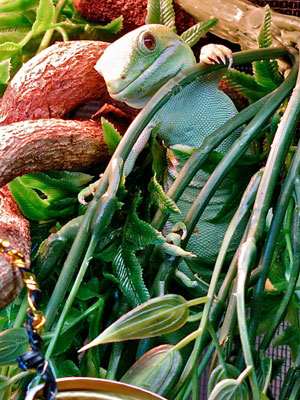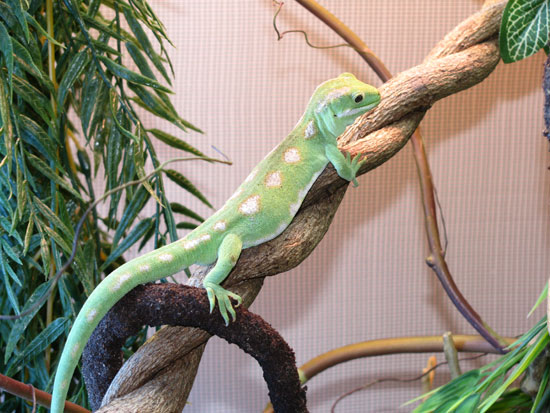[ad#250]
Naultinus geckos are a genus of gecko that I was always fascinated with but never thought that I would have the opportunity to work with. What made these secretive geckos so interesting to me was their beautiful colors and appearance, their diurnal and arboreal nature, and that they are live-bearing geckos that come from a completely different environment than most other geckos out there. I was always curious as to why these geckos could withstand prolonged periods of cold and thrive while most other gecko species needed a relatively warm climate. How did evolution play a part in this genus and how could they have survived for this long by producing a maximum of two offspring per season? Being that these geckos are such low producing animals, they will never be readily available to the consumer, and therefore they will also have a relatively high price tag. These traits make Naultinus a gecko for gecko lovers, not for those looking for an “investment animal”. With this being said there will always be a demand and a lot of hype surrounding these mystical creatures.
[ad#sponsor]
The Naultinus grayii comes from the Northern section of the North island of New Zealand where it is typically found in bushes of the tea tree plant. This species lives the majority of its life off of the ground, and its green and white pattern provides it excellent camouflage. At times an animal will be right in front of my eyes on a bush and it takes me a minute to see it, and then I almost feel dumb for not having seen it right away. The grayii is a very patient predator. They do not stalk their prey like other geckos, instead they wait for an insect to come within striking distance and then they make their move on it. This must help the gecko preserve its strength since in the cold climate they live in they can’t afford to waste any energy.
Housing Naultinus grayii
I keep a pair of adult naultinus grayii in an 18” x 18” x 36” zoo med screen cage. I furnish the enclosure with dense hanging brush, cork flats, and as ground cover I use a cork tube as a hide. I also offer them vines and other pieces of wood to climb on, and I observe them using these occasionally to relocate themselves to another part of the enclosure, or to bask on. I have this pair setup in as naturalistic a setup as possible attempting to replicate their indigenous natural climate and landscape as much as possible. Although they are mostly in the hanging brush they will occasionally go into a moist hide on the ground of this enclosure to shed or to retreat. I use a layered substrate of eucalyptus leaves, eucalyptus mulch, wood chips, and New Zealand sphagnum moss in this order from bottom to top layer. I use this mixed ground cover because the eucalyptus has anti-bacterial and anti-fungal properties while the top layer of moss and wood chips holds water while helping to keep the ambient humidity up. I spray the foliage and the inside of the moist hide every morning and never let the temperature in the screen cube rise above 80F in the summer. In the winter I cool these geckos to temperatures as cold as 40F. In all seasons I provide these geckos with ample UV light. I use three 18” 5.0 UVB fluorescent strip lights on top of the cage and one additional exo-terra fluorescent 5.0 bulb which sits directly above a bush where the geckos can bask. I provide basking spots from as close as 1 inch from these lights to ensure proper UVB exposure which is essential to this geckos’ well-being.
Care and Breeding
I feed my naultinus as much variety as I can. Staple insects include but are not limited to roaches (dubia, banana, and Madagascar hissing), gut-loaded crickets, blue bottle flies, waxworms and waxmoths, silkworms, hornworms, and on occasion they will get a superworm or a mealworm. I rotate the gutload of the feeders constantly and I cycle the brands of vitamins and minerals that I dust prey items with. This extensive feeding regimen seems to contribute to the good overall health of this gecko, no question.
Naultinus grayii require a lengthy brumation period of very low temperatures to successfully conceive and produce offspring. These animals will breed in the early springtime and give birth anywhere from late summer to the end of fall having either one or two live born neonates per season. Once the juveniles are birthed they can fend for themselves and can be housed either separately which is best or with their litter mate or another grayii of similar age.

Difficulties in Obtaining Naultinus
Aside from the limited amount of offspring a single female can produce, these geckos are very difficult to obtain due to the laws surrounding them and their transport. They are marked on Appendice III of CITES (the convention on international trade in endangered species of wild fauna and flora), which makes their export or import tricky, as several requirements need to be met in order for permission to be granted by this organization. Since New Zealand doesn’t allow any of their wildlife to be exported it is impossible to acquire wild caught animals, or even captive bred animals from within New Zealand. Because of this, as well as the high dollar amount being paid for Naultinus, in recent times it has become quite common for individuals to attempt to smuggle these geckos; this has put added pressure on natural animal populations. To obtain legal documentation for export of Naultinus from Europe to the U.S., for example, one must prove that the animal was not obtained illegally. This is done by showing that the animal has been produced in captivity from legally acquired parents which doesn’t sound too bad, but many of the animals out there are not documented with legal paperwork even though the animals themselves are captive bred animals.
I feel that these geckos are one of Earth’s precious jewels and I am grateful to have the opportunity to be working with them. They truly are a rewarding species to work with. I have high hopes for my pair this season and time will tell whether they will produce young, but at this time in the summer all signs point to the female being gravid. Good times…




This animals are very very nice.
Hi i love the great stories i have just read on the Naultinus Grayii gecko. I was lucky enough to keep these wonderful geckos in Taranaki several years ago along with other breeds of gecko. However i moved to Whangarei 9 years ago and now keep golden bell green frogs. When i had the geckos i managed to get hold of a device from one of the gecko breeders, and this would catch live moths and other night time flyers in the trap. The geckos bred and did so well with the wonderful diet of live pray and other food i provided.However i do not have that moth catcher anymore as due to unforseen circumstances i sold it.I have not been able to find anyone here in New Zealand that has one. Can you folk help me?.Kind regards from Wilkie.
Hi, I am curious about the body mass of geckos. I have been trying to track down information on geckos but have found nothing published which I can use as a source. Do you have the average mass of your animals – do you use that to estimate how much food to give them?
@Ricardo-thanks, I will relay the message to them 😉
@Wilkie-I have heard of people making these types of traps themselves and have a book on New Zealand geckos that lays this out step by step. There are also a lot of other New Zealand folks that catch their own feeder insects, and a great source of information is the people at the NZ herpetological society. If you want to email me, I can scan the pages and send them to you ([email protected]). I think that they are easy to make, you may even be able to find directions online.
@Trish-The body mass of geckos can range from a gram to several hundred grams depending on the species. These geckos are in the 40 gram range I’m guessing. I haven’t weighed them as I don’t feel the need to do so to animals that look healthy, eat, and behave as they normally should. You say that you can’t find any information on geckos, I’m assuming that you are referring to Naultinus geckos as there is not much information on them online, but there are a few books with some information on them out there. If you are referring to other genus/species there are many forums with plenty of info, you just will have to look through a lot of material. You can email me too if you have specific questions 🙂 Like I said, I don’t really weigh my animals very often at all, and therefore your answer is no to the question about whether the mass of the geckos determines whether I will feed them or not. I think that type of feeding regiment is implemented on captive birds of prey in order to assure that they return to their keeper lol. I estimate how much food I give my geckos by talking to others and by the procedure of trial and error for the most part, and of course depending on the species that I am dealing with. If I feed every 3rd day with 6 crickets and the gecko only eats 3, then the next time I will feed the gecko 3 crickets (that’s just an example really, but I’m sure you get the point). Or if the gecko is fed on a Monday and when I feed it on Wednesday and it doesn’t eat or eats very little I come to the assumption that this particular gecko may not need to eat so frequently. Of course this type of observation is done over the course of time, not just a one or two consecutive feedings and that is how I determine an average number of prey items as well as the interval between feedings. The temperatures and season also effects how much a particular gecko will eat as will age and sex as well as the type of feeder, the size of the feeder, and whether the feeder has been gutloaded by feeding it good foods. I hope that helps you out a little…..oli
Hi – just a quick “hello” to say that I think you are doing a MARVELOUS job with these geckos, and you should be proud to that you’re taking such great care of them and trying hard to create a habitat that simulates their native home. I’m a Crested Gecko fan myself, and I was looking for info on other gecko species. Thank you – your info is very informative, and it shows a true love for the reptile. I really enjoyed reading the info and looking at the pictures. Great job with EVERYTHING! Jennifer
where do i buy naultinus from?